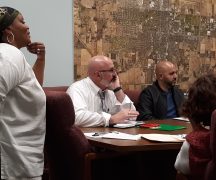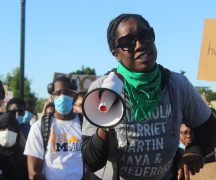By JAN LARSON McLAUGHLIN
BG Independent News
If the U.S. wants to reverse its legacy of racism, white people are going to have to acknowledge the country’s history first – and recognize that the injustices continue today.
As Martin Luther King Jr. Day nears, members of Not In Our Town Bowling Green discussed the role that white people need to shoulder if meaningful changes are going to be made.
“It hurts my heart that this racism occurred and still occurs,” NIOT Co-chairperson Emily Dunipace said during a meeting of the organization on Thursday.
“We have to continue talking about this,” she said. “It’s going to take white people talking about this.”
Dunipace talked about a calendar on the Equal Justice Initiative website, that identifies past racist incidents committed on each day of the year. Many of the injustices went unnoticed to white people, she said.
“It didn’t affect us,” so it wasn’t discussed at the dinner tables of white families, she said.
“These are not pleasant topics. This is about learning,” she said. “It’s going to take white people talking about it to make it change. We need to make it stop.”
NIOT Co-chairperson Ana Brown said a sense of humanity is key.
“Try to put yourself in the shoes of people who experience this every day,” Brown said. “Our humanity calls us to make it better.”
Though many Americans believe racism is a thing of the past in the U.S., the murder of Ahmaud Arbery says otherwise.
Arbery was shot and killed on Feb. 23, 2020. After the shooting, Arbery’s killers were allowed to leave the scene and faced no consequences for months, as local officials refused to fully investigate the incident. It was not until video footage of the shooting surfaced and gained national attention that officials arrested the three white men involved.
On Friday, the men convicted of murder for chasing and killing Arbery were sentenced to life in prison, with a Georgia judge denying any chance of parole for the father and son who armed themselves and initiated the deadly pursuit of the 25-year-old Black man.
The Superior Court judge said Arbery left his home for a jog and ended up running for his life for five minutes as the men chased him in pickup trucks until they finally cornered him.
“Ahmaud Arbery was hunted down and shot, and he was killed because individuals here in the courtroom took the law into their own hands,” the judge said.
Though slavery was abolished more than 150 years ago, the Equal Justice Initiative calendar points out several racial injustices that have occurred since then. Following are some of the incidents that took place in the month of January in years past.
- On Jan. 2, 1944, 15-year-old Willie James Howard, a Black boy, was kidnapped and lynched by three white men in Suwannee County, Florida, after being accused of sending a love note to the daughter of one of the men.
- On Jan. 6, 1959, Richard and Mildred Loving were convicted of interracial marriage, given a one-year suspended sentence, and banished from the state of Virginia by court order.
- On Jan. 8, 1908, newly elected Governor Austin Crothers declared it his administration’s “high and momentous obligation” to “eliminate the illiterate and irresponsible” Black voters from Maryland’s electorate.
- On Jan. 9, 1961, thousands of white people violently rioted because Charlayne Hunter and Hamilton Holmes registered at the University of Georgia, becoming the university’s first Black students. Their enrollment came days after federal judge William Bootle ordered the university to admit them, ending a two-year administrative and legal fight to integrate the school.
- In the early morning hours of Jan. 10, 1966, two carloads of armed Ku Klux Klan members drove onto the property of Vernon Dahmer and his family, 10 miles outside of Hattiesburg, Mississippi. The white men set fire to the Dahmers’ grocery store and house and blasted the buildings with gunfire. His wife and children managed to escape, but Dahmer sustained fatal lung damage while holding off attackers as his family fled; he died later that day. For years, Dahmer and his wife, Elli, had slept in shifts to keep watch over their home in anticipation of attacks from local white terrorists. As a successful Black businessman and NAACP leader active in the voting rights movement, Mr. Dahmer and his family were the targets of local white residents’ hostility and violent attacks.
- On Jan. 21, 1948, Senator James Eastland of Mississippi led a successful campaign to block an anti-lynching bill, which would have held members of lynch mobs and local law enforcement officers accountable for their role in racial terror lynchings.
- In the pre-dawn hours of Jan. 23, 1957, a Black man named Willie Edwards Jr. was declared missing when the truck he was employed to drive was found abandoned along the road near Montgomery, Alabama. It was later discovered that four white men had forced Edwards to jump to his death from a bridge for allegedly “offending a white woman.”
- On Jan. 26, 1970, the United States Supreme Court issued a decision upholding the Georgia Supreme Court’s decision to close, rather than integrate, a local public park in Macon, Georgia.
- On Jan. 31, 1964, the night before he was set to move to Milwaukee, Wisconsin, Louis Allen was ambushed outside his property in Liberty, Mississippi, and shot twice in the face with a shotgun. Allen was the witness to the murder of a man registering Black voters. He had asked for witness protection, but was denied.





